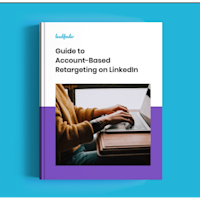As they say, “better late to the B2B retargeting game than never”.
And by they, I mean us.
Did they just self-quote themselves?
You’re damn right I did. Don’t make us do it again.
With our inner dialogue out of the way, let’s talk retargeting. Or remarketing. Tomayto tomahto.
Whatever term you choose to throw at stakeholders, there’s no denying that retargeting is one of the most important tools for maximizing marketing ROI.
In short, retargeting is a tactic that involves positioning yourself in front of potential prospects already familiar and engaged with your brand.
By engaged I mean, they’ve visited your website, signed up for a newsletter, downloaded a piece of content, and so on.
The reason why remarketing often proves so effective is because 80 percent of the buying process is over and done with prior to the first direct interaction.
In other words, when a prospect reaches out to a sales rep, their mind is already 80 percent made up on whether or not they’ll purchase.
Compared to other marketing-based tactics, remarketing converts up to 50 percent of web traffic — versus the two percent converted with search campaigns.
On its own, when you consider that 98 percent of your overall visitors leave without converting, remarketing opens the door to re-engaging them across the web.
The result: an over 85 percent increase in conversion.
The perks of remarketing include:
Sustaining brand awareness (while they are looking at your competitors), in effect, generating leads
Nurturing leads by keeping potential customers engaged
Recapturing lost leads
Note: Want to see the companies that have visited your website and are ideal for retargeting? Sign up and give Leadfeeder a try—free for 14 days.
The B2B retargeting difference
Before I get into the real nitty-gritty, a quick recap.
Letting 98 percent of web visitors enter and exit without so much as a wanting glance = bad. 👎
Re-capturing their attention with remarketing = good. 👍
Retargeting tactics make it possible to maintain (and build upon) brand awareness, nurture leads by keeping potential customers engaged with your business and recapture lost leads.
Online display advertising is a common example of retargeting people will point to.
In the wild, think about the last time you visited an e-commerce site, put a pair of shoes in your shopping cart, checked your bank account, and then talked yourself out of buying them.
You closed the window in your browser and breathed a sigh of relief — proud of yourself for beating consumerism. Until those same shoes start appearing in ads across the web.
This is a go-to method of B2C retargeting. Unfortunately, it doesn’t work in quite the same way for B2B marketers.
B2B retargeting differs from B2C in the fact that:
The buying decisions aren’t made by a single person. They involve input from multiple decision-makers and stakeholders at various levels of involvement.
Because of this, the sales funnel for B2B companies is much longer than it is for B2C companies.
The buying decisions aren’t typically made by the final decision-maker. It’s often an employee of the decision-maker, who makes the call after hours of researching, demo-ing, and presenting their top choices to those up top.
B2B marketers are targeting entire accounts. When retargeting then, it helps to reach as many key personnel from a company as you can.
In summary: traditional remarketing fails B2B marketers because their concern lies with companies, not individuals.
This explains why the phrase “account-based retargeting” is all the rage right now.
B2B remarketing best practices and strategies
Knowing that B2B remarketing is a worthwhile tactic for your business — and that it comes equipped with its own set of nuances to consider — where to start?
For a business starting from scratch, that question is especially daunting — even more so when you’re fielding it from higher-ups looking to you to answer it.
The key here in easing your fears and setting forth a B2B retargeting strategy you can actually deliver on is to focus your efforts.
Identify the ways in which remarketing could be used to further enhance what you’re already doing.
Here are some B2B remarketing best practices and strategies to consider.
Remarketing to customers at each stage of the B2B sales funnel
Objective: capture leads according to where they’re at in the sales funnel.
The typical length of a sales cycle for B2B businesses can range anywhere from four to seven months. This is a considerably long time to keep prospects engaged.

And a major driver behind the need for multiple touchpoints. It takes six to eight touchpoints, in fact, to generate a viable sales lead.
If you’re heavily relying on search traffic currently, consider the aforementioned stat — only 2 percent of said traffic converts to business.
This leaves 98 percent of prospects left hanging in the awareness or consideration stages of your funnel.
Remarketing opens the door to connect with that 98 percent — pending you know where they’re at and how to engage them.
Approach your B2B retargeting journey by first acknowledging the three main stages at which you can remarket to customers:
Lead generation
Lead nurturing
Proposal
Then, get to work with the finer details.
Create remarketing lists
Objective: understand your users as subsets of a larger whole. Target them with highly-unique, crafted messaging.
It’s important to have your sales funnels mapped out — you know that. But more importantly, it’s important to have your prospects mapped out by sales funnels.
Leadfeeder users can segment and create custom remarketing lists with custom feeds.
These remarketing lists should be transient in nature. You should be working to move potential customers from one list to the next — or, more broadly speaking, to conversion.
Set parameters in your CRM so that certain actions will trigger the reassignment of a prospect to new lists as they move further down the funnel. In doing so, you can deliver hyper-relevant content that suits their evolving level of interest.
Targeting leads based on where they’re at in the buying process, whether through ads or email, helps to boost conversion rates by 72 percent.
Example: accounts-based remarketing lists for ads
Creating accounts-based B2B remarketing lists for ads is easier to do than it sounds, especially with help from Leadfeeder.
With our platform’s ability to identify website visitors and track behavioral data, you can retarget whole accounts on LinkedIn, the Google Display Network, Facebook, and Instagram.
For LinkedIn, simply download a Custom Feed from within Leadfeeder as a CSV and use it to upload and create a Matched Audience in LinkedIn.
Below is an example of a custom feed created in Leadfeeder for remarketing lists on LinkedIn.

For Facebook, Instagram, and Display Ads, load your Custom Feed CSVs into Metadata.io and let the platform work its magic.
Consider this tutorial your new best friend. 👯♀️
Example: remarketing lists for your existing email subscribers
Just because someone signed up for a webinar or downloaded a piece of content, doesn’t mean they’re automatically on their way to becoming a paying customer.
They need nurturing, just like everyone else.
Here is a great example from Iterable.
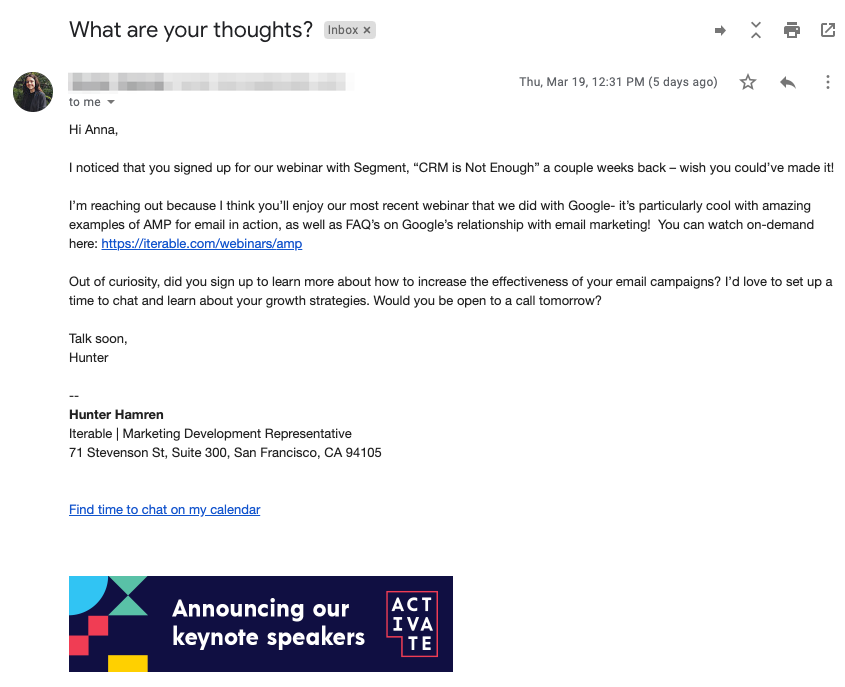
When you have a list of emails at your disposal, remember that not every email is created equal. They’re all at different stages of consideration based on what they’ve shown interest in.
For this reason, you can approach remarketing to email subscribers based on the following groupings:
Prospects that visited a landing page (e.g., webinar, content download, or newsletter-focused) but exited.
Webinar signups that didn’t attend.
Webinar attendees that didn’t convert.
Prospects that downloaded content but didn’t convert.
Newsletter subscribers that aren’t yet customers.
To help in list segmentation, consider the quality of your forms. Are you asking for the right information? Are you asking for too much information?
Make sure your forms are reflective of where a prospect is at in their journey.
Those at the bottom of the funnel probably aren’t as likely to hand over as much information as those further along in the journey.
Create unique landing pages specific to user experience
With an understanding of who you’re trying to remarket to based on where they’re at in the sales funnel, you can begin thinking through what messages to serve them with.
You’re likely delivering said messages through an email, ad, or — more often than not — a landing page.
An effective landing page should work to encourage a specific call-to-action. The keyword here is specific.
You didn’t put all of that work into segment customer lists only to send them all to the same landing page. Each segment is relative to a unique customer experience.
A prospect presumably reaches a landing page by clicking on a website search result, social post, ad, email newsletter, or blog post.
If the offer is relevant to them and intriguing enough, they’ll take the steps to fill out a form on the landing page, which then converts them from a visitor to a lead.
Or from one remarketing list segment to the next.
If a prospect lands on a page and does not convert, it may not be because they’re uninterested in your product or service. The information on the page simply wasn’t relevant to them.
They might just need a follow-up and additional information that better speaks to the problems they’re looking to solve.
In building out an effective landing page, make sure to include:
A short and persuasive headline that sets up the offer
A subheading that frames the offer with a hook
An image or video that visually displays the quality of the offer
A brief paragraph of copy that explains the benefits of the offer (i.e. what someone will receive in exchange for their contact information)
One clear, compelling CTA that entices the visitor to claim the offer
A short form to complete in claiming the offer
Social proof, in the form of a testimonial quote or review, that further highlights the value of the offer
A couple of types of landing pages you can use in moving a prospect toward conversion include:
Example: B2B content landing page
A content landing page can be a page on your website that further details topics relevant to your product or service (e.g., a blog post or white paper download page).
The idea here is to help prospects advance from awareness to consideration. You want to show that you know your stuff — that you understand the problem at large and how to solve it.
Here is an example of a B2B landing page from Search Engine Journal.

Example: social proof landing page
A social proof landing page showcases how customers were able to use your product or service to successfully meet their needs. Think in terms of case studies and testimonials.
B2B marketers seldom market to the final decision-maker.
Because of this, it’s better to provide this level of information to visitors so they can collect the information in the research phase and make recommendations internally to those in charge.
Here is an example from our friends at Pipedrive.

Example: B2B sales landing page
A sales-based landing page is used for those further down the funnel. You’re making a more direct call-to-action for purchase.
These could be realized as a demo, price quotes, or free trial pages. They essentially allow those who have shown enough interest in your content to contact your company and convert.
While you’ll want to diversify your content across these different types of landing pages, you don’t necessarily have to start from scratch for each one.
Instead, consider repurposing content across landing pages (e.g., blog posts, videos, infographics, etc.), using the messaging around them to frame relevancy.
Here is an example from our customers at Cloudtalk.io.
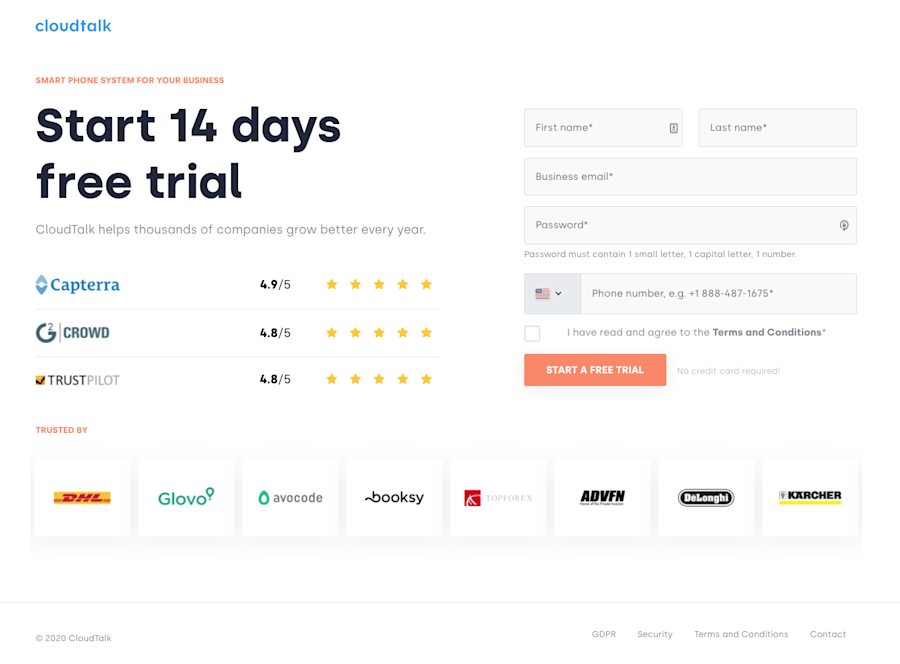
Create supporting B2B sales content
Think of content as an overarching word for how you choose to package a particular message.
The specific types of content you create may include blog posts, infographics, videos, flowchart graphics, white papers, and emails.
Like this follow-up email to users after they have downloaded our website visitor tracking guide.
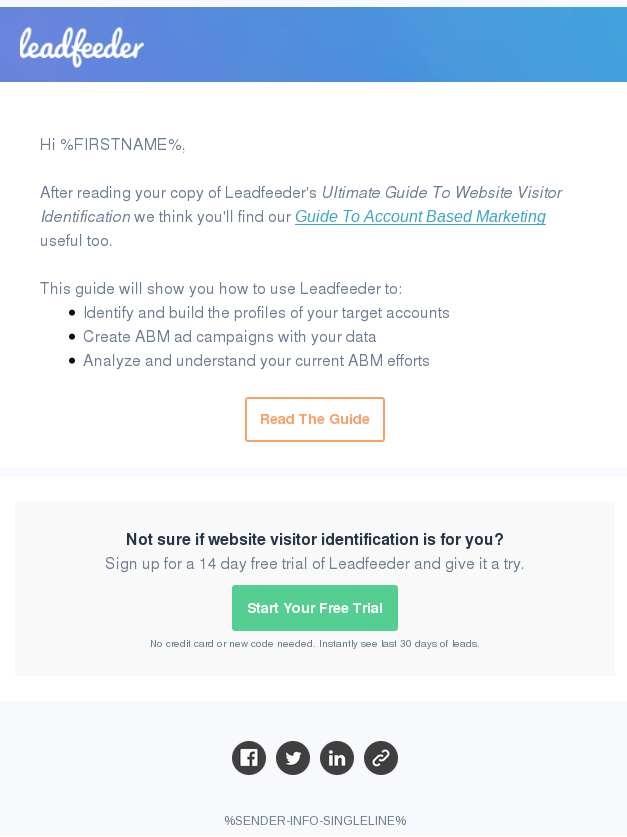
Instead of constantly promoting your products and services, B2B marketers have embraced the softer sell of content marketing.
Distributing relevant content is a more effective approach for attracting and retaining prospects than pushing what you’re selling with no care for where someone is at in their buying journey.
Constantly delivering content that provides insights and addresses prospect pain points can help marketers obtain useful information about their audiences.
The short-term goal might be to send an email that subscribers want to open. But the long-term goal is to ultimately nurture a relationship over time that results in a sale.
This comes back to the idea of multiple touchpoints.
For example, here is the last email Leadfeeder sends 30 days after the initial ebook download.

While many organizations aggressively bombard prospects with sales pitches during the last 43 percent of the buyer’s journey, there’s plenty of opportunity prior for piquing interest.
Here are some common types of content to produce at different stages of the B2B sales journey:
B2B sales content for lead generation
In the lead generation stage, visitors are identifying their problems and ways to solve for them. And, more importantly, the role your company has to play in helping to do just that.
Blog posts developed around relevant keywords and subject matter deemed important to your audiences are a great way to attract visitors to your website.
Keywords used should display informational intent. In other words, you’re looking to answer questions often posed by your intended audiences.
The end goal with this type of content is to position yourself as a company with a thorough knowledge of the industry and customer needs. You can be trusted.
Companies with a blog tend to generate 67 percent more leads than those that don’t.
B2B sales content for lead nurturing
At this stage of the sales journey, you’ve captured a customer as a lead. But leaving them as such doesn’t do either of you any good.
They’ve shown interest in your product or service and identified it as a viable solution relative to whatever problem it is they’re trying to solve.
The goal here in nurturing their consideration is to continuously build trust.
You need to produce content for them that further establishes your expertise in the field — driving home the fact that your product is the optimum solution.
This can be done by creating longer form, heavily detailed pieces of content. If you can include original research and data, even better.
Gauge interest for leads by offering white paper downloads, guides, or newsletter sign-ups. You’re essentially upping the ante — asking prospects for more information in exchange for more in return.
>>Find extensive detail on lead nurturing in our full guide on the subject.
B2B sales content for proposals
After nurturing, come proposals. You’ll inevitably reach a point where it’s time to make that hard sales pitch — which means you’re close to sealing that deal.
The goal at this stage is to assure customers of their decision and remove any lingering doubts or fears from the equation.
Prospects at this stage are often deep in the competitive research phase. They’ve likely narrowed in on their top choices and are actively weighing the pros and cons of each.
Hit them with case studies, testimonials, and reports or white papers with original research. It may also be useful to complement this content with discounts and demos.
It’s still a good idea, even in this top-funnel stage, to avoid overly sales-y calls-to-action. Instead, opt for CTAs like, “Request a Demo” or “Contact Us” to ease them into motion.
Create B2B lookalike audiences
Objective: find other audiences relevant to your product or service.
Both Google and Facebook’s advertising platforms make it easy to reach new audiences with their lookalike features. In uploading your email lists, you can generate new lists.
These new lists are created based on similar online behaviors. In Google Ads, this functionality is referred to as Customer Match, while on Facebook it’s known as Lookalike Audiences.
Another way to retarget similar audiences is to use LinkedIn’s website retargeting feature.
LinkedIn is a no-brainer for B2B businesses — said to be 277 percent more effective at generating leads than Facebook and Twitter.
Create ads for remarketing
With lookalike audiences built out and retargeting pixels in place, ads are the next piece of the puzzle. And often, paid promotion is necessary for getting in front of audiences both old and new.
You've probably seen something like this scrolling through Facebook?
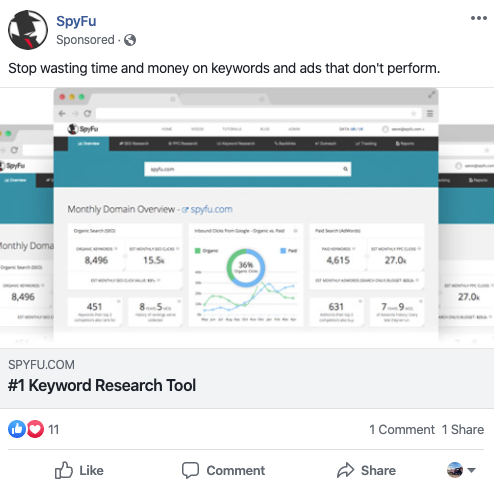
That's a retargeting ad.
B2B marketers tend to go the route of PPC (pay per click) ads. Essentially, an advertiser pays every time someone engages with their ads online.
Clicks are the most common form of engagement. But depending on the type of content served in an ad, marketers can also advertise for other actions such as video views or lead form submissions.
There are three types of PPC ads used in B2B remarketing:
Search ads
Display ads
Social ads
A Sample B2B retargeting strategy: putting all of the pieces together
It’s one thing to know what goes into a successful B2B retargeting strategy, it’s another to actually implement one.
Here are a few basic scenarios for putting these tactics to work for your business:
Lead generation
B2B retargeting strategy end goal: drive a lead to schedule a meeting or call.
Remarketing strategy: using lists built around prospects in the consideration stage, target them with branded ads pointing them to a demo or discount-focused landing page.
The idea is to keep your company top-of-mind online.
For leads that visit the landing page but don’t sign up, retarget them with testimonial-based content to further establish trust.
For leads that visit the landing page, sign up, but don’t show up for the call or meeting, follow-up with a personalized email from a sales rep that further established the benefits of your product or service.
Lead nurturing
B2B retargeting strategy end goal: drive a lead to get a price quote or proposal.
Remarketing strategy: Send your segmented list of leads consideration-based content that further establishes proof of value.
This can be in the form of testimonial videos or downloadable case studies.
If a lead downloads the case study, you can follow-up with a personalized email from a sales rep that makes a harder pitch for your product or service.
Proposal
B2B retargeting strategy end goal: drive a lead to make a proposal inquiry or purchase.
Remarketing strategy: Use a personalized email from a sales rep to tailor the messaging around highly relevant content and pricing details.
You can also incentivize sign-up with discounts or extended free trials.
Once a deal is closed, you can use remarketing for retainment purposes. The idea is to nurture loyalty, drive referrals, and encourage upsells when it makes sense.
Final thoughts: how to use B2B remarketing for lead generation and conversion
In a digital world driven by personalization, I can’t stress enough the benefits to be found in retargeting B2B audiences with useful, relevant messaging.
And despite the many moving parts, it’s not as complicated as it’s made out to be. Especially with tools at your disposal to organize and identify the audiences you’re trying to connect with.
Consider Leadfeeder one such tool. I’ll help your team turn anonymous website traffic into a loyal customer, fancy account-based marketing buzzwords into ROI.
Note: Want to see the companies that have visited your website and are ideal for retargeting? Sign up and give Leadfeeder a try—free for 14 days.
Now that you're here
Leadfeeder is a tool that shows you companies that visit your website. Leadfeeder generates new leads, offers insight on your customers and can help you increase your marketing ROI.
If you liked this blog post, you'll probably love Leadfeeder, too.
Sign up